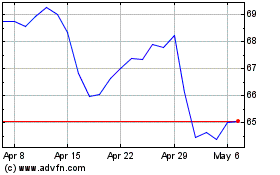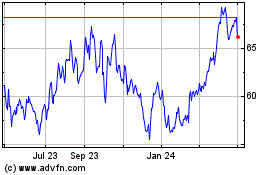By Rebecca Elliott, Christopher M. Matthews and Cara Lombardo
Just weeks ago, Occidental Petroleum Corp. Chief Executive Vicki
Hollub sought to reassure investors that her bold bet on U.S. shale
oil -- a $38 billion deal for rival Anadarko Petroleum Corp. --
hadn't left the company on shaky footing.
An analyst asked on Feb. 28 if Occidental could weather the
coronavirus outbreak and pay its beefy dividends as usual. "We're
actually in a good scenario, I think, because we don't expect this
situation to last," she said.
Soon after, oil prices crashed to around $30 a barrel, the
fallout from a price war erupting between Russia and Saudi Arabia
that threatened to further flood the world with crude. Ms. Hollub
was forced to slash the dividend by 86%, the company's first such
cut in decades and, this weekend, cede major ground to Carl Icahn
by ushering the activist investor into the embattled company's
boardroom.
Mr. Icahn, a longstanding critic of the Anadarko deal, phoned
Ms. Hollub March 12 to say he had increased his stake in the
company to nearly 10%. After months of calling for Ms. Hollub and
her board to be replaced, Mr. Icahn employed a well-worn line,
telling her she could have peace or war, said people familiar with
the call.
"They promised to be prudent," Mr. Icahn said in an interview.
"Yet they risked a great deal of the company's assets on an
extremely imprudent deal."
The following week, when oil plunged below $30, Occidental was
preparing to bring back its former chief executive Stephen Chazen
as its new chairman, giving Mr. Icahn two seats on its board and
approval of a third, independent director, The Wall Street Journal
reported Sunday. The company declined to comment for this
article.
The unfolding drama at Occidental is one example of the
disastrous financial threat to U.S. oil and gas producers from
demand and supply shocks upending the oil market.
Using horizontal drilling and hydraulic fracturing techniques to
powerful effect, these shale-oil companies over the past decade
turbocharged U.S. production to about 13 million barrels a day, the
most in the world. Now, heavy debt loads and poor returns, which
have turned off lenders, leave them with limited wiggle room to
manage an oil rout.
Occidental has slashed its planned spending by roughly a third
and likely will limp along through low oil prices despite being
highly leveraged. Yet its market capitalization has plunged below
$10 billion from more than $46 billion on the eve of its bid for
Anadarko last April, a deal at a time when oil prices were more
than twice current levels.
As of Friday, Occidental had lost roughly 82% of its market
capitalization in a year, a greater share than all but eight
companies in the S&P 500 index, according to Dow Jones Market
Data.
Bankruptcy looms for many others in the U.S. shale patch --
those with smaller balance sheets and higher interest rates.
Scores of oil-and-gas companies, including Hess Corp. and
Pioneer Natural Resources Co., approach survival mode, cutting
spending and curtailing drilling. On average, drillers have slashed
budgets by about 30%, according to a Bernstein Research analysis of
dozens of public producers that have disclosed revised spending
plans.
Ms. Hollub, the first female chief executive of a major oil
company, faces the biggest challenge of her career: steering
Occidental through the chaos while seeking to placate Mr. Icahn.
When the venerable activist investor called Ms. Hollub on March 12,
he let her know that a regulatory filing would soon reveal he had
quadrupled his stake in Occidental, and that he was gunning to
replace the company's board, people familiar with the matter
said.
Mr. Icahn then offered a truce of sorts -- his "peace or war"
line -- and concluded that peace was better. Mr. Icahn didn't say
it, but the implication was clear: Ms. Hollub had a chance to save
her job if she struck a deal.
The next day, Occidental said it had adopted a "poison pill"
provision to make it harder for Mr. Icahn or other activists to
amass larger stakes in the company, a common takeover defense
tactic.
About a week later, Occidental was nearing a settlement with Mr.
Icahn.
Mr. Chazen agrees with Mr. Icahn that Occidental should be open
to a sale if oil prices recover sufficiently, some of the people
familiar with the matter said.
Mr. Chazen won't campaign for the CEO position or accept it if
offered to him, some of the people said. Mr. Chazen was only
willing to come back if Mr. Icahn and Ms. Hollub blessed it, these
people said. Still, there is no guarantee the alliance will work.
Some people familiar with the matter say Mr. Chazen and Ms. Hollub
haven't always seen eye-to-eye.
"The reason former CEOs exist is so the new ones can blame all
the problems on them," said Mr. Chazen, who declined to comment on
any settlement between the company and Mr. Icahn.
Deep debt
Even before the crash in prices, some Occidental investors were
heading for the exits over concerns about the company's
post-Anadarko debt load. Occidental's debt totaled about $41
billion as of year-end, more than four times earnings, excluding
interest, taxes and other accounting items, according to S&P
Global Market Intelligence, up from about one times earnings a year
earlier.
"There was a path to the acquisition of Anadarko being
successful. But it was a very narrow needle hole to thread," Noah
Barrett, an energy analyst for Janus Henderson Investors, said. In
hindsight, he called the deal "a complete disaster." Janus had
about $375 billion in assets under management as of year-end and
was an Occidental investor, though the funds where Mr. Barrett has
a say sold their positions in the company late last year.
The impact of plummeting demand from the pandemic, coupled with
the oil-price war, could linger into next year.
Larger investment-grade oil-and-gas companies should survive,
said Todd Dittmann, head of energy at Angelo Gordon, which manages
about $33 billion across a range of alternative-asset
strategies.
Riskier, high-yield companies, many of which managed to
restructure and emerge from bankruptcy in the last downturn, face
bloated expenses, steep debt and unprofitable wells, he said,
putting their survival in question. These companies, primarily
small- and medium-size shale producers, make up about a quarter of
U.S. oil production.
"Many may turn out to be less going concerns and more future
liquidating trusts," Mr. Dittmann said.
The list of shale companies struggling with debt includes
Whiting Petroleum Corp. and Chesapeake Energy Corp., a fracking
pioneer co-founded by the late wildcatter Aubrey McClendon.
Before the global spread of the coronavirus, many in the
industry had hoped for a wave of consolidation to cut costs and
combine the assets of companies that might not survive on their
own.
Though the collapse in crude prices has left oil-and-gas
companies such as Occidental vulnerable, Regina Mayor, who leads
KPMG's energy practice, said she didn't expect activists to descend
on the industry and force marriages. That would require a belief in
the underlying strength of oil-and-gas companies.
"It would be actually a bet on the sector," she said. "I would
not go to Vegas and bet on that."
Shale kings
Occidental was once seen as an attractive midsize alternative to
Exxon Mobil Corp. and Chevron Corp., with a healthy dividend and
relatively low leverage. It was long known for its smaller,
conservative acquisitions. But it bulked up on shale just as
investors were turning against the industry after years of poor
returns.
The company's deal for Anadarko was largely to achieve economies
of scale in America's top oil field, the Permian Basin that
stretches through Texas and New Mexico. The acquisition made
Occidental the largest producer in the region, Rystad Energy data
show.
To seal the deal, Ms. Hollub outbid much larger rival Chevron,
which had initially offered $33 billion for Anadarko. Chevron
pulled out of negotiations after Occidental's counteroffer.
As part of the merger, Occidental took on roughly $12 billion of
Anadarko's debt and issued roughly $22 billion in new debt to
finance the transaction, according to securities filings. It also
struck a deal with Warren Buffett's Berkshire Hathaway, which
agreed to spend $10 billion in exchange for 100,000 Occidental
preferred shares yielding 8%, or $800 million annually, to help
complete the deal. Mr. Buffett didn't respond to a request for
comment.
Mr. Icahn has said Ms. Hollub pursued the deal to fend off
takeover bids from larger competitors. Exxon has long been
interested in acquiring Occidental, according to people familiar
with the matter. Occidental declined to comment on whether the
prospect of a takeover influenced its decision to acquire
Anadarko.
While Mr. Icahn isn't arguing for a fire-sale of the company, he
expects oil prices to rebound and continued consolidation in the
Permian Basin. Yet given the energy industry's lack of appetite for
deals in the market tumult, Mr. Icahn and Ms. Hollub may be stuck
with each other for a while.
"The world's changed, and I don't think people are going to be
out there looking for bargains anytime soon," said Mark Stoeckle,
chief executive of Adams Funds, which owns about 350,000 of
Occidental's shares.
Write to Rebecca Elliott at rebecca.elliott@wsj.com, Christopher
M. Matthews at christopher.matthews@wsj.com and Cara Lombardo at
cara.lombardo@wsj.com
(END) Dow Jones Newswires
March 22, 2020 14:57 ET (18:57 GMT)
Copyright (c) 2020 Dow Jones & Company, Inc.
Occidental Petroleum (NYSE:OXY)
Historical Stock Chart
From Mar 2024 to Apr 2024

Occidental Petroleum (NYSE:OXY)
Historical Stock Chart
From Apr 2023 to Apr 2024
